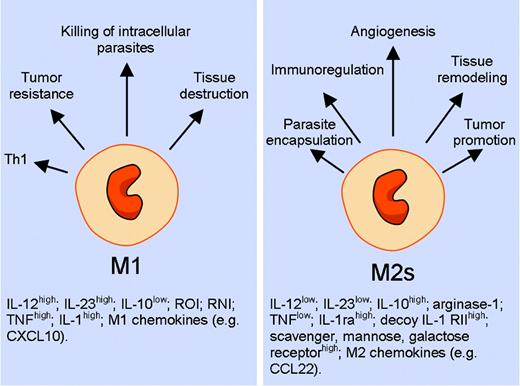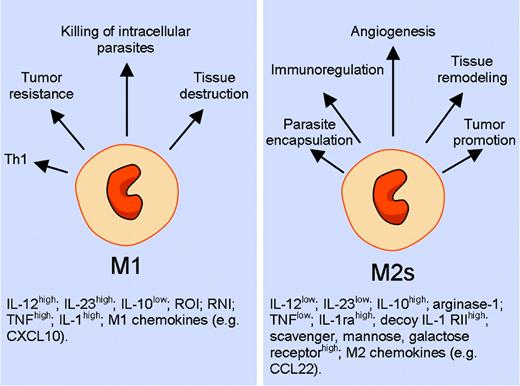Comment on Ghassabeh et al, page 575
Polarized activation of cells of the monocyte-macrophage lineage into M1 and M2 cells is an operationally useful, simplified descriptor of the functional plasticity of these cells. Ghassabeh and colleagues now put to the test the actual in vivo validity and significance of the M1/M2 paradigm.
The microbial and cytokine milieu drives macrophages to express specialized and polarized functional properties.1,2 Interferon-γ (IFN-γ), selected cytokines (granulocyte-macrophage colony-stimulating factor [GM-CSF], tumor necrosis factor [TNF]) and microbial products (lipopolysaccharide [LPS]) elicit a classic M1 form of macrophage activation. M1 macrophages are generally characterized by interleukin (IL)–12high, IL-23high, IL-10low phenotype; produce copious amounts of reactive oxygen and nitrogen intermediates and inflammatory cytokines; are part of the afferent and efferent limb of polarized Th1 responses; and mediate resistance against intracellular parasites and tumors (see figure).
M2 is a generic name for various forms of macrophage activation other than classic M1 and includes cells exposed to IL-4 or IL-13, immune complexes, IL-10, and glucocorticoid hormones.2 The various versions of M2 cells generally share an IL-12low, IL-23low, IL-10high phenotype; have high levels of scavenger, mannose, and galactose-type receptors; orient arginine metabolism to ornithine and polyamine, and hence to growth promotion; and are IL-1 receptor antagonist (IL-1ra)high, decoy IL-1 type II receptorhigh, IL-1blow, caspase1low.3 M1 and M2 cells express profoundly different repertoires of chemokines and chemokine receptors (the “chemokinome”).2 M2 cells are diverse, but in general are involved in T helper 2 (Th2) response; have immunoregulatory function; orchestrate encapsulation and containment of parasites; and promote tissue repair, remodeling, and tumor progression. Immature myeloid suppressor cells share functional properties and components of the transcriptome with M2 cells.4 FIG1
Key properties and functions of polarized macrophages. ROI and RNI indicate reactive oxygen and nitrogen intermediates. M2s refer to diverse forms of M2 activation.
Key properties and functions of polarized macrophages. ROI and RNI indicate reactive oxygen and nitrogen intermediates. M2s refer to diverse forms of M2 activation.
The paradigm of macrophage polarization is essentially based on in vitro results. In this issue of Blood, Ghassabeh and colleagues report on their systematic effort to characterize macrophages from 3 models of parasite infection (Trypanosoma brucei brucei, Trypanosoma congolense, and Taenia crassicens) and 1 transplanted tumor. Macrophages were obtained at stages of the diseases corresponding to a predominance of M2 orientation. Myeloid cells were profiled using a differential gene expression approach. Using these diverse disease models, Ghassabeh and colleagues identify a gene signature shared by the various ex vivo–obtained M2 populations. The common signature included documented M2-associated genes (eg, arginase 1, mannose and galactose receptors, etc) as well as a new set of molecules not previously associated with M2 macrophage polarization. The functional significance and specificity of the new M2-associated genes remain to be defined. Interestingly, some of these genes could not be induced using M2 stimuli in vitro, emphasizing the importance of the in vivo approach.
This and a study on tumor-associated macrophages4 complement results obtained in gene-modified mice reviewed in Mantovani et al5 and provide much needed in vivo evidence of the validity of the macrophage polarization paradigm. However, these results also emphasize the diversity of the activation/differentiation states within the broad “M2” category and caution against a simplistic rigid view of the M1-M2 dichotomy. It will now be important to explore the significance of macrophage polarization in clinical conditions, where information is scanty, and the validity of new molecules as markers and, possibly, targets for therapeutic intervention. ▪



